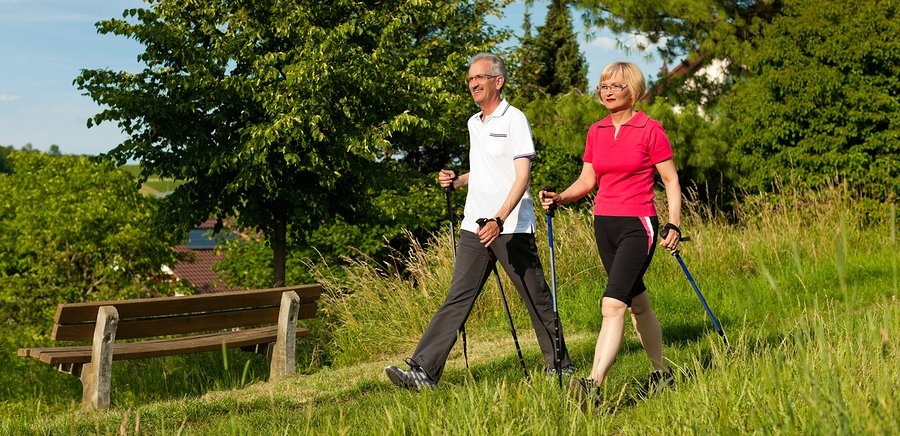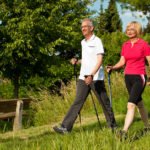Now that the weather is warm, it is especially nice to take a stroll in the late afternoon or evening. It feels good to gets some physical activity after a long day at work, and the fresh air is wonderful after hours spent mostly indoors. But instead of a slow, meandering kind of walk, you might want to try setting a more brisk pace because according to new research, a little extra speed could help you live a longer life.
The study, which took place at the University of Sydney in Australia, found that walking at a faster pace is associated with a lower risk of early death.1 Stamatakis, Emmanuel; et al. “Self-rated walking pace and all-cause, cardiovascular disease and cancer mortality: individual participant pooled analysis of 50,225 walkers from 11 population British cohorts.” British Journal of Sports Medicine. 31 May 2018. Accessed 10 June 2018. http://bjsm.bmj.com/content/52/12/761. These results are based on an evaluation of 11 lifestyle-related surveys answered by residents of England and Scotland from 1994 through 2008, in which the subjects reported their physical activity levels and included the pace of their walking. The responses were then compared to the medical records of any participants who had died.
This analysis showed that the people who typically walk at an average pace have a 20 percent lower risk of early mortality from any cause than their peers walking at a slower pace. And those setting an even faster pace reduced their risk by 24 percent over the slowest walkers. Brisk walking was defined as approximately three to four miles per hour in general, but the investigators emphasized that pace is really determined by each individual exerciser’s fitness. Therefore, keeping a pace that results in breaking a sweat or becoming slightly breathless is that individual’s fast pace no matter what they are clocking for distance.
Curiously, heart disease risk at first appears to have been impacted differently by the pace of the walking. The participants who walked at an average speed reduced their chance of an earlier death due to cardiovascular disease by 24 percent over the slower walkers, and those who walked faster cut their risk by 21 percent.
But interestingly, when the data was broken down by age, the numbers reverted to form. The subjects 60 and above who reported walking at an average pace had a 46 percent drop in their risk of dying from cardiovascular disease vs those who walked slowly, and those who walked at a brisk pace had a whopping 53 percent drop in risk over their counterparts who walked slowly.
While all-cause mortality rates and heart disease mortality rates were notably lowered by a quicker pace of walking, there was no direct correlation seen to a reduction in mortality rates due to cancer. And all of the findings held steady even after the researchers controlled for potentially influential factors such as overall fitness levels, body mass index, age, and gender.
The research was somewhat flawed by its dependence on self-perception by its subjects. What one person considers to be a very fast-paced walk may be slow to another. And while, as the investigators reminded us that setting a pace that raises your heart rate it what’s really important, it’s possible that some of the participants might not have been fully accurate about the speed of their walks.
Although the study was not designed to prove cause and effect, it certainly did demonstrate a link between the pace of walking and lifespan. Walking has been found in prior research to benefit brain health, help prevent diabetes, and, like the current study, increase longevity. And a 2010 study at Appalachian State University in Boone, North Carolina showed that walking at a moderate pace for 30 to 45 minutes daily increases the amount of immune system cells present in the body.2 Nieman, David C.; et al. “Upper respiratory tract infection is reduced in physically fit and active adults.” British Journal of Sports Medicine. 1 November 2010. Accessed 11 June 2018. http://bjsm.bmj.com/content/early/2010/09/30/bjsm.2010.077875.
Ultimately, this serves as a great reminder that walking, even at a moderate pace, is something all of us at every age can do, and it can be a valuable part of your workout. Even if you don’t think you have time to go for a 45-minute walk every night, it is easy to squeeze in shorter walks throughout your day. But if you want to take advantage of the latest research that shows that faster is better, go for a brisk 20-minute power walk at lunch. Walk around your building and include a few flights of stairs to get your heart pumping harder. Park your car as far as possible from your errands to increase the distance you’ll have to walk to each store. There are lots of ways to be creative, so put on a good pair of walking shoes and get moving!
References
| ↑1 | Stamatakis, Emmanuel; et al. “Self-rated walking pace and all-cause, cardiovascular disease and cancer mortality: individual participant pooled analysis of 50,225 walkers from 11 population British cohorts.” British Journal of Sports Medicine. 31 May 2018. Accessed 10 June 2018. http://bjsm.bmj.com/content/52/12/761. |
|---|---|
| ↑2 | Nieman, David C.; et al. “Upper respiratory tract infection is reduced in physically fit and active adults.” British Journal of Sports Medicine. 1 November 2010. Accessed 11 June 2018. http://bjsm.bmj.com/content/early/2010/09/30/bjsm.2010.077875. |











